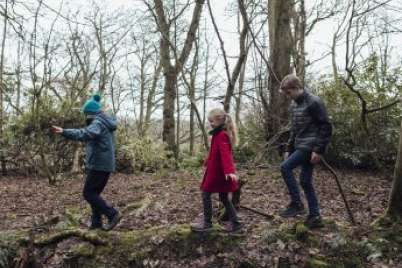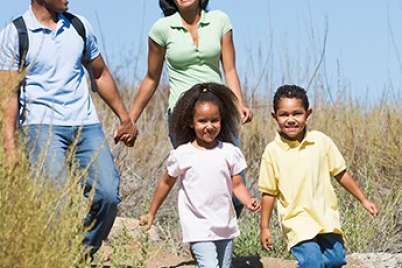
Why kids need to play with mud, tires, fire, and junk
Editor’s note: This post was updated on Jan. 23, 2020.
In your mind’s eye, envision a public playground. You probably see a slide, swings, maybe a fort-like structure, some monkey bars, and one of those climbing structures made of rope. If the playground’s new, it might be in bright primary colours that nicely complement the towers or houses nearby.
Now imagine a playground in apparent disarray, scattered with loose, random parts, like shovels, rope, a tire that some kids are rolling down a hill, and a mound of mud. Wait, is that a fire pit, complete with marshmallows being toasted?
Mud, tires, fire, and junk are what you’ll find at the Vivo Play Project in Calgary, a four-year research project designed to explore how play can support health and wellness in Canadian suburbs.
The Vivo Play Project is flipping the traditional playground on its head through a series of experiments that include “loose parts” activations at existing parks, purpose-built play hubs, and co-creation sessions with the surrounding community. One of its hallmarks is the Play Hub, which sits outside the Vivo for Healthier Generations centre, formerly known as the Cardel Place community recreation centre in northeast Calgary.
According to Kris Kelly-Frère, Vivo’s play project and senior innovation manager, many suburban children are growing up in environments that are rich in technology but lacking in adventurous free play. It’s only when families see the difference in how kids play in these loose-parts playgrounds that they understand what they’ve been missing.
“Given the world we’re living in with a heavy focus on technology, these types of experiences are pretty foreign to the average family in north-central Calgary,” says Kelly-Frère. “That’s why we built a Play Hub at Vivo first. We lit a fire outside our front door and invited people to a potluck so they could see what it’s like.
“We have 3,000 square feet of mud out there—big, giant piles of mud—and I’ve yet to hear a parent complain about their kid getting muddy. But if we told them, ‘We’re going to drive your kids through mud,’ they’d say, ‘No.’”
What does the Play Hub look like? View this short video to find out.
The $3.5-million project is partially funded by a grant from the Public Health Agency of Canada, the Suncor Foundation, and other donors. Vivo’s plans include the construction of six to eight community Play Hubs in north-central Calgary neighbourhoods, and the ongoing training of Play Ambassadors who facilitate play—and educate parents—at loose-part activation events.
Vivo is also about to embark on a $63-million expansion project to transform the existing recreation centre into a true community hub.
“We’ve been in dialogue with our community, using different engagement processes—narrative interviews, qualitative surveys, and forums—asking, ‘What’s your recipe for living well? What are your ingredients to living a good life?” says Kelly-Frère.
“And they’re saying things like mindfulness and balance, access to the outdoors, spontaneous play, and social connection. They’re not saying we need more sport, as important as sport is.”
More free play and praise, less management time
Back in 2011, Vivo found that children registered in recreational programs were spending less than half their time in those programs moving and playing. Based in part on that finding, Vivo introduced what it calls the 4-in-1 physical literacy program, aimed at helping kids develop foundational movement skills such as coordination, balance, strength, agility, and fine motor skills. Key components include increasing free play during each session, decreasing formal and structured class time, and providing more encouragement and praise when kids are being active.
Since 2011, a central Vivo initiative has been the training of Play Ambassadors, a crew Kelly-Frère describes as “human Swiss Army knives.” These facilitators not only work at the Vivo centre and the outdoor Play Hub, but also at community play events.
In addition, Kelly-Frère suggests that when all the research is in after the completion of Vivo’s four-year Play Project experiment, there’s a chance the Play Ambassadors will prove to be the most vital component.
Related read: Be a lifeguard to your child’s “risky” play
The ambassadors do everything from creatively setting up the play environment to bringing materials to monitoring play sites for potential hazards. If kids have tied ropes together to create a climbing structure, the Play Ambassadors will watch to see what the kids do and decide whether to intervene to manage potential risks. But the ambassadors are more than just monitors: they also do research using scanning tools to track behaviours on site and also communicate with parents, says Kelly-Frère.
“We say it’s a hybrid between a camp leader, a site planner, a social innovator, and a research assistant… It’s a really diverse, interesting, change-making role,” he says.
Risks, hazards, and the helicopter parent
Kelly-Frère tells the story of his moment as a “panicked helicopter parent,” when he pulled his four-and-a-half-year-old daughter off a piece of equipment while he stood right next to the sign he wrote about risk and playing to the child’s ability level. He’s now teaching himself, along with other parents, to back off a little as their kids play.
“We help people understand the difference between risks and hazards,” he says. “A hazard is something dangerous that you can’t anticipate or mitigate or prepare yourself for, such as that piece of glass hidden under water in the sand. A risk is an environment, challenge, or tool, which is at the edge of your ability. And risk is contextual to the person. For a parkour ninja, jumping onto a shipping container isn’t a big deal. For a four-year-old or someone who has never been at heights, it is.”
Vivo believes that taking risks, and mastering climbing something high by yourself, with caring and watchful adults there to help if needed, is important to you feeling capable as a human being. Kelly-Frère says Vivo has had a “remarkably small number of incident reports,” and Play Ambassadors are trained to continually monitor what’s going on during each event.
One of the unknowns is what may result from Vivo’s play experiments. While parents and communities expect loose parts to be locked up to ensure safety once a Vivo activation or event is over, there may be a time down the road when local communities get keys to a shipping container full of those parts.
“We’re working now with the City of Calgary to approve the permitting, so that we can build these hubs,” says Kelly-Frère. “And we’re involving the community associations and the neighbours around there, to get them to sign off. We are required do line-of-sight surveys. We cannot just say that we’re dropping a storage cube into a field beside a park; we need to have two thirds of the community to say, ‘Yes, we’re good with that happening,’ and that anyone who can see that cube is okay with our proposed location and plan.”
Related read: Six ways kids should engage in risky play
Advice for parents and play leaders: experiment and collaborate
Vivo and the City of Calgary are not alone in experimenting with loose parts and adventure play projects. Kelly-Frère estimates that similar projects are being tried in at least 10 other Canadian cities.
Anyone who’s interested in changing play within their community shouldn’t have difficulty finding others who want to change it too, he says. In communities across Canada, parents and community organizers have found support from school boards, community halls, city recreation leaders, and other partners willing to provide space for loose parts play.
Alternatively, parents can take a baby step towards introducing their communities to loose parts play simply by bringing along balls, rope, or other interesting objects that can break the monotony of a slide-and-swings playground, he says.
“Help kids notice that there’s a giant pile of leaves, or that they can actually get lost in the bushes. Or say, ‘Look at all this gravel!’ Help them notice that abundance. Most of all, stand back and observe. Think about your best play memory. Were your parents there? Chances are, they weren’t. That’s where the magic is… when children are able to explore and play freely.”
Photos courtesy of Vivo.






